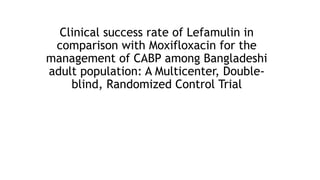
Clinical success rate of CABP with Lefamulin in.pptx
- 1. Clinical success rate of Lefamulin in comparison with Moxifloxacin for the management of CABP among Bangladeshi adult population: A Multicenter, Double- blind, Randomized Control Trial
- 2. Background • Community-acquired pneumonia remains ubiquitous as a major clinical concern worldwide. Over 2.5 million deaths globally were attributed to pneumonia in 2017, with the majority occurring in individuals 70 years of age and older (∼1.1 million) and children under 5 years (∼800,000). • The mortality rate is as high as 23% for patients admitted to the ICU. All patients with comorbid illness are considered at risk for pneumonia. • One of the most common co-morbid factors are chronic obstructive pulmonary disease (COPD) and in older individuals, asthma can be another significant risk factor. • Other comorbid conditions increasing the risk of developing CAP include congestive cardiac failure, diabetes mellitus, alcoholism, hepatic, renal insufficiency, and malignancy.
- 3. • For healthy outpatient adults without comorbidities, the IDSA/ATS Guideline recommends monotherapy with amoxicillin as first line and monotherapy with either doxycycline or a macrolide as alternatives • For outpatient adults with comorbidities the Guideline recommends combination therapy with amoxicillin-clavulanate plus either a macrolide (preferred) or doxycycline OR monotherapy with respiratory fluoroquinolone. • Recent treatment regimen suggests the alternatives to amoxicillin-based regimens which include combination therapy with a cephalosporin plus a macrolide or doxycycline OR monotherapy with lefamulin. • American Guideline mentioned two newest antibiotics, omadacycline and Lefamulin. Lefamulin is a novel semisynthetic pleuromutilin antibiotic with oral and IV formulations approved by FDA on 19 August 2019 for the treatment of CAP.
- 4. • In the absence of hepatic impairment or drug interactions, lefamulin is a potential alternative to fluoroquinolones. • The clinical efficacy and safety of lefamulin have been studied in 2 phase III randomized clinical trials for CABP, Lefamulin Evaluation Against Pneumonia (LEAP) 1 and LEAP 2 . • The LEAP 1 and LEAP 2 trials were both double-blind, double dummy, parallel-group, randomized trials that evaluated lefamulin versus moxifloxacin in adults with moderate to severe CABP. • Safety was assessed in all randomized patients who received any amount of study drug. Lefamulin was noninferior to moxifloxacin in the rates of ECR as well as the EMA test-of- cure populations in both trials.
- 5. Rationale This study will examine whether Lefamulin is superior to Moxifloxacin for the treatment of CABP in Bangladeshi adults ≥ 18 years of age. The study will also compare safety between treatment groups and evaluate susceptibility of Lefamulin in this population.
- 6. Objectives • Primary Objectives Demonstrate the superiority of Lefamulin versus comparator with respect to the clinical success rate in the Intent-to-Treat (ITT) Analysis Set. Demonstrate the NI of lefamulin versus comparator with respect to the Investigator’s Assessment of Clinical Response at Test of Cure (TOC) (i.e., 5-10 days after the last dose of study drug) in the modified-ITT (mITT) and Clinically Evaluable at TOC (CE- TOC) Analysis Sets. • Secondary Objectives Evaluate the Early Clinical Response in the Microbiological Intent-to-Treat (microITT) Analysis Set. Evaluate the Investigator’s Assessment of Clinical Response at TOC in the microITT and Microbiologically Evaluable at TOC (ME-TOC) Analysis Sets. Evaluate the By-Pathogen Microbiologic Response at TOC in the microITT and METOC Analysis Sets. Evaluate the safety and tolerability of lefamulin versus comparator in the Safety Analysis Set. Evaluate 28 day all-cause mortality in the ITT Analysis Set.
- 7. Clinical success rate referred to CABP to be cured (i.e., successfully treated) if patients were alive and met 3 conditions: At least 2 of 4 CABP symptoms (difficulty breathing, cough, chest pain, production of phlegm) improved, and No CABP symptoms worsened, and No extra antibiotics were needed to treat the infection
- 8. Inclusion Criteria 1. Be male or female at least 18 years of age. 2. Provide written informed consent and be willing and able to adhere to the study-specified procedures and restrictions. 3. Have an acute illness (less than or equal to 7 days duration) with at least 3 of the following symptoms consistent with a lower respiratory tract infection (new or worsening): 1. Dyspnea. 2. New or increased cough. 3. Purulent sputum production. 4. Chest pain due to pneumonia. 4. Have at least 2 of the following vital sign abnormalities: 1. Fever (body temperature > 38.0 °C (100.4 °F) measured orally or equivalent temperature from an alternate body site) or hypothermia (body temperature < 35.0 °C (95.0 °F) measured orally or equivalent temperature from an alternate body site). 2. Hypotension (systolic blood pressure < 90 mmHg). 3. Tachycardia (heart rate > 100 beats/min). 4. Tachypnea (respiratory rate > 20 breaths/min). 5. Have at least 1 other clinical sign or laboratory finding of CABP: 1. Hypoxemia (i.e., O2 saturation < 90 % on room air or while receiving supplemental at subject's baseline requirement or PaO2 < 60 mmHg). 2. Auscultatory and/or percussion findings consistent with pneumonia (e.g., crackles, egophony, dullness). 3. White blood cell (WBC) count > 10 000 cells/mm3 or < 4 500 cells/mm3 or >15 % immature neutrophils (bands) regardless of total WBC count. 6. Have radiographically-documented pneumonia within 48 hours before enrollment (i.e., infiltrates in a lobar or multilobar distribution or diffuse opacities on chest x-ray or chest computed tomography scan consistent with acute bacterial pneumonia). 7. Have a Pneumonia Outcomes Research Team (PORT) Risk Class of II, III, or IV and be an appropriate candidate for oral antibiotic therapy as treatment for the current episode of CABP.
- 9. Exclusion criteria 1.Have received more than a single dose of a short-acting oral or IV antibacterial for CABP within 72 hours before randomization. 2.Require concomitant systemic antibacterial therapy potentially effective against CABP pathogens. 3.Have a nonbacterial cause of pneumonia (e.g., viral pneumonia) 4.Have a noninfectious cause of pulmonary infiltrates (e.g., pulmonary embolism, chemical pneumonitis from aspiration, hypersensitivity pneumonia, congestive heart failure, bronchial obstruction, lung cancer, cystic fibrosis). 5.Have confirmed or suspected pleural empyema (does not include sterile parapneumonic effusions).